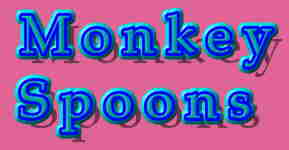
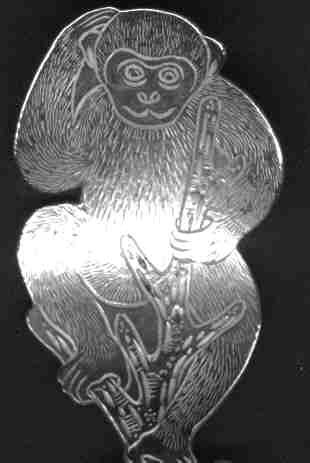
This is the only monkey on this page, and he is not even a "monkey spoon". But as you can see he is scratching his head and wondering, just as we are doing about these very strange spoon/ladles.
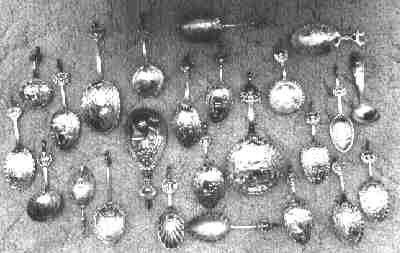
The term "monkey spoon" has been applied to a very unusual ladle/spoon that was used by the Dutch settlers who settled in the New York/Hudson River area in the state of New York. The above photo shows one of the largest collections of these strange spoons.
Three events were of utmost importance to these early settlers: birth, marriage, and death. Life was very hard and unforgiving, but if the remote settler communities were to grow and prosper there was a need for "community" and there was a need for new life.
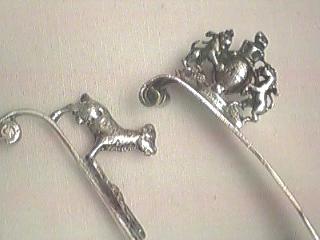 unusual finials
unusual finials
The English and some continental societies placed a great emphasis on births. The occasion of a birth was a blessed event and parties and gatherings were held. Prosperous citizens would often give an apostle spoon to new born babies at the time of their christening. The silver spoons bore the image of an apostle as the finial. The hope was that the baby would observe this finial every time it was fed. One spoon was often used by a person for their entire life. The phrase to "be born with a silver spoon" stems from this practice.
But the Dutch settlers of the Hudson Valley region were not as religious as other groups and they did not place the same emphasis on births. Instead they place greater emphasis on marriage and a very heavy emphasis on death. They did, however, adapt the concept of using a spoon to symbolize these important life transitions.
 Marriage Heart
shaped bosses
Marriage Heart
shaped bosses
On the occurance of a marriage or funeral, very large elaborate parties were planned. All of the neighbors would be invited, and drinking and merrymaking would often last throughout the night. A funeral was NOT a sad situation as it is in our society. Early reports indicate that funerals were very large and expensive events.
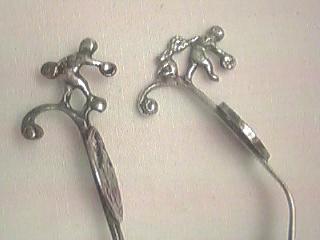 Weighing the soul of the departed
Weighing the soul of the departed
The Dutch have always been known as heavy rum drinkers and the American Dutch dominated the world-wide rum business. A major reason for the success of the Dutch in New England was the trade in rum which was a leading industry and contributed significantly to the wealth of the entire region during the pre-colonial period.
One of their favorite social drinks was a mixture of rum and raisins. This drink was served in a large punch bowl and special silver spoon/ladles (monkey spoons) would be hung from the rim of the bowl. Merry makers would then dip the ladles in the bowl and either drink directly from them, or would then pour the rum into another container for imbibing. Most monkey spoon bowls are solid, but a few have piercings to allow the rum to drain out, thus keeping only the raisins.
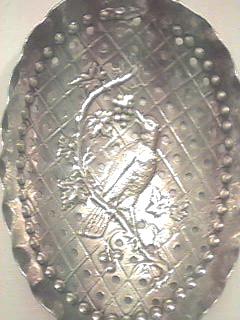 pierced marriage "love bird"
pierced marriage "love bird"
Monkey spoons were usually custom made and often reflect the nature of the event. Most of them are funeral spoons and show various death symbology or show important facets of the decedents lives.


Marriage monkey spoons often show hearts and flowers and usually show a couple engaged in talking, walking etc.
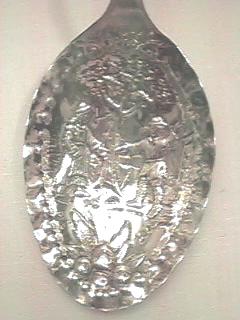

Of course at any party, all of the monkey spoons owned by the family would be hung on the punch bowl so there would be a mixture of pieces often extending back generations.
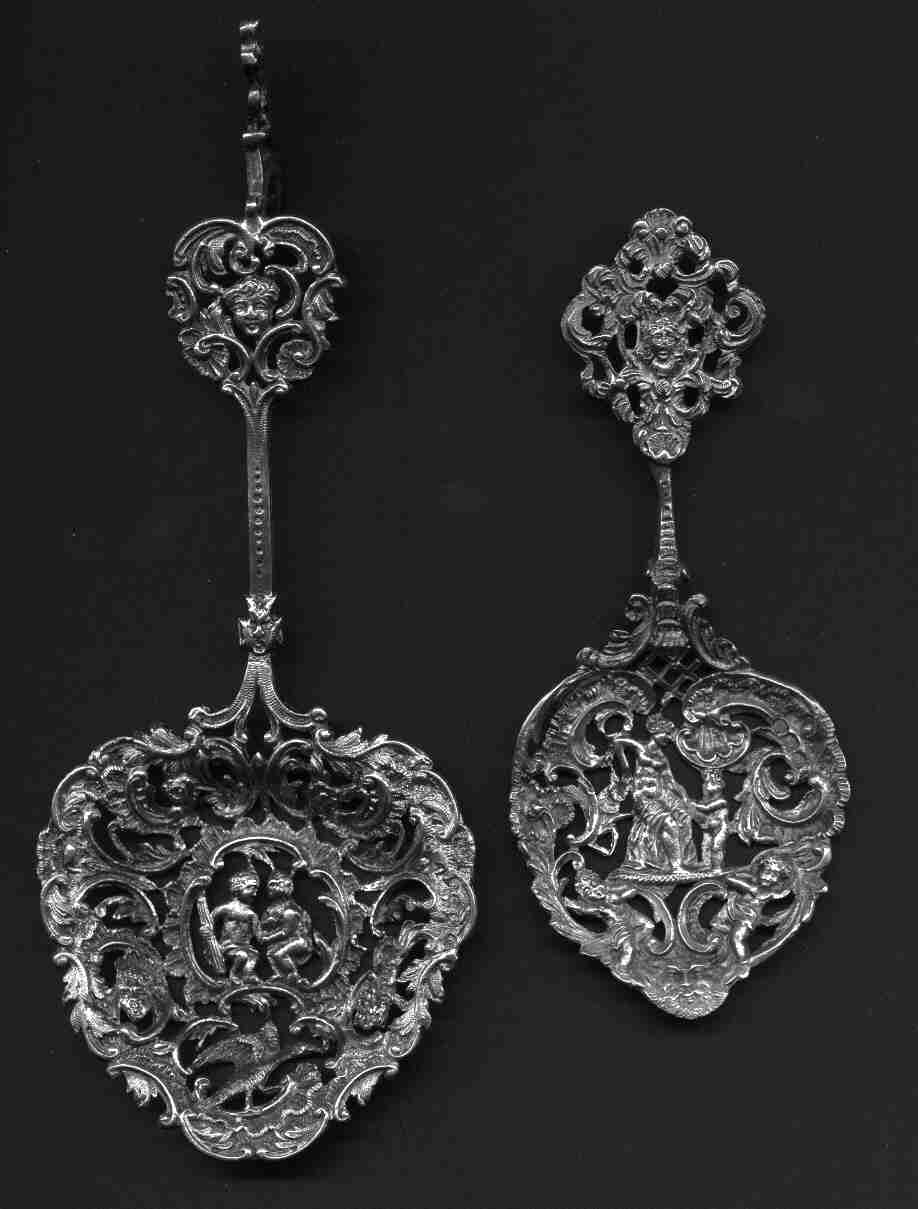
Styles of monkey spoons changed over the years and were often related to prevailing silver styles. The closeup of the bowl (left) shows two men shaking hands, while one is holding a club. Besides all the cutout rococo ornamentation there is also a female head, a bird (I think it is a Canadian Goose, but I don't know enough about birds), and a male head with handlebar mustache. (these two faces are on the left and right of the bowl, but are very hard to see in the photo). I have found a set of "hidden" English marks which I have never before noticed. They date this spoon to 1889-90. I suspect that it is a marriage spoon because of the male and female faces and because of the bird finial. The English bon-bon spoon next to it is very similar in construction and dates to 1892-3.
That is a good question, and no one knows for sure. Several hypotheses have been made and you are free to accept the one that suits you.
1. Since the monkey spoons all have a hook on the stem and they hang by that hook, it would "look like a monkey hanging by its tail" (my favorite).
2. Most monkey spoons have a small figural emblem on the high part of the curve. I haven't seen any that look like a monkey (Some later reproductions supposedly had a monkey as a word play on the name), but there is one style that is very hard to figure out. Some people see a "monkey" in this figure.
3. When people drink too much they often act strangely. In Dutch the term "zuiging the monkey" is a reference to drunkeness.
Take your choice. There is no "wrong" answer.
A word on the photographs: Monkey spoons are highly three dimensional. They typically have a large bowl, a curving stem, a front boss and a cast finial. It is impossible to take a two-dimensional picture from any angle and show the entire spoon. Therefore, I have reproduced some pictures of bowls, a picture of finials, a picture of bosses, and a picture of two spoons where the light has been deliberately set up so that it causes the finial to cast a shadow. Sorry folks, that is the best I can do under the circumstances.
Bowl of typical funeral spoon with life style image. This one shows an ice fisherman wearing skates and carrying his fishing equipment.
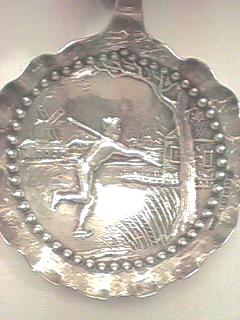
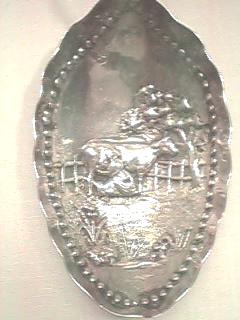 Milk Maid in life
Milk Maid in life
 Very religious person
Very religious person
This finial is the one that is often described as a "monkey"
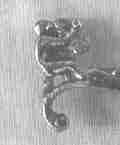
This is the largest monkey spoon which I have ever seen and it is more than two and a half times the size of a normal monkey spoon. The quarter gives relative size. The boss is a typical funerary urn. Heart shaped bosses are usually found on wedding spoons.
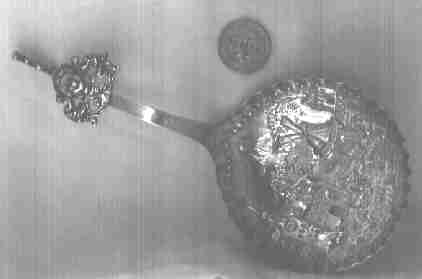
Spoon with lighting designed to cast a shadow so that you can see the "dimensionality".

 examples of "death"
bosses
examples of "death"
bosses
 unknown purpose--doesn't fit into any
categories
unknown purpose--doesn't fit into any
categories
return to SPOON WORLD HOME PAGE